|
Ask us, We Answer
Do you have a Nordic training, technique, equipment, travel, or event question?
Just email us at weanswer@skipost.com |
|
Cold Weather Table?
Dear SkiPost,
I am looking at tablets and want a tablet that will work well in the cold with Coaches Eye (Android) and a custom timing package I have. So while the rest of the world argues HD vs other and selfy ready cameras, in your experience is there any tablet that continues to work well in the cold of race day mornings and all the other times we find ourselves out there? What about rain? Best to plan on conductive gloves, or a touch friendly cover? P N
Please email weanswer@SkiPost.com your suggestions
|
|
Wearing a Hat?
Would you please respond to the issue of wearing hats to help maintain core temp and thus not jeopardize performance. Our middle school & high school girls are into looking good with brightly colored headbands that leave much of their hair & head exposed to the elements. Today at the JNQ Sprint races in Wausau we had pouring rain (it could have just as likely been heavy wet snow) coming down that was totally saturating their head/hair as well as their race suits. While coaches are concerned with the wax on their athlete's skis, it does not seem like they are as concerned with lessened performance due to inappropriate dress. I am not talking about sunny 30+ race days. I was always taught that if core temp was maintained or even increased - the extremities (legs/arms and the muscles in those legs and arms) would perform at a higher level than if the body was chilled and the blood was being shunted to the core. Is this old school thinking? I believe if an expert responds to this, I have a better chance of being listened to when I tell them to put a hat on!
Frozen Coach
Yes, the human body performs best when its core temp remains around 98.6 degrees Fahrenheit (37 degrees Celsius). Too cold (or too hot) and performance quickly drops. We lose heat through conduction, convection, radiation and evaporation. We constantly release heat in the form of radiation. Conduction occurs when our bodies give away heat to that other object that we are in contact with that has a lower temp, like snow or air particles. Convection occurs when we transfer het to air particle through motion i.e. "wind chill" Finally, when as we sweat, ( or get wet) we transfer heat through evaporation, as water on our skin transforms into a gas. Since our bodies naturally give away heat to colder, active particles, air particles in wind, and water particles (snow and rain) can accelerate that effect.
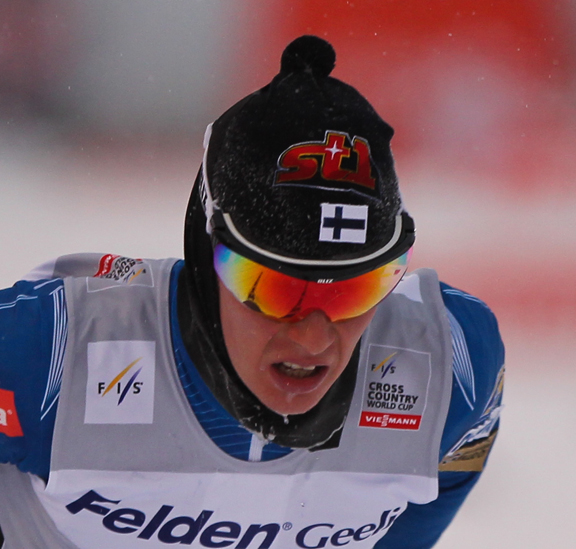
To combat rapid cooling, we shiver to generating heat by exciting our muscles. In the cold many parts of the body blood vessels in our skin tissue constrict, or tighten up to keep blood away from the cold outer layer of the body and helps circulate warmer blood to our core areas. But this tightening is not good for peak performance and racing.
Why a hat? Because areas around the head, neck, chest and groin don't constrict as effectively as the smaller ones near the skin and thus more even more susceptible to heat loss. Furthermore water is denser than air, so it absorbs more heat (up to 32 times more) than air. So when you are skiing in rain or snow you can get hypothermia quicker if the rain or snow is falling on your uncovered head and neck.
That's why Nordic racing attire includes a hat and often neck gaiter.
When your core temperature down to 95 degrees or below it is called hypothermia. When your re-warming reactions are not enough to overcome the cooling process, hypothermia can set in and skiing performance will decrease quickly. Mild Hypothermia includes shivering, goose bumps, difficulty with complex motor skills Moderate Hypothermia includes violent shivering, sluggish, speech problems, difficulty with fine motor skills. Severe Hypothermia includes rigid muscles, dazed, shivering has stopped, blue skin, erratic heart beat.
So dress properly, starting with your first layers and finishing with a hat and neck gator to race better.
Andy at SkiPost
|
|
Coaches' Corner
By Megan Spurkland, PSIA National Nordic Team
"An Amazing Video Analysis App!"
I am so excited to share this! I have to give the credit to my husband, Jan, who discovered an app for our iPad (there is also an Android version) called Coach's Eye. I have never had such an amazing and easy time doing video analysis, and I think you will find it ridiculously easy, fast, affordable and well-received by your athletes. It is an app by TechSmith, and costs a whopping $4.99. Here's how it works:
First: You take video footage with your iPad. You can take separate clips of skiers or put them all in one segment.
Second: You go home, click on the video you want to watch and hit "Analyze." At the bottom this little reel will appear and you can drag your finger back and forth on it and watch the skier in slow motion. You will see a toolbar on the left that allows you to make circles, arrows and draw lines. You can split screen and add a second video alongside, link them together and make them ski in simultaneous slow motion. I promise that if I think this is easy, you will, too! You can play around with the video, deciding what your movement analysis (M.A.) for that particular skier is, and plan out how you want to present it to them.
Third: When you are ready to present a finalized M.A., you click on a red button on the top of the screen and it starts recording whatever it is that you do. It is also recording your voice!! So, you take the skier step by step through their movements, circling pole tips, boots or highlighting torso angles while you do it, talking to them specifically. It has a little corner tab called "Clear," so after you draw a few angles you can hit "clear" and then slow-mo the skier to the next position. Remember that you can be recording the split screen with two skiers, also! When you are done, hit the red button again.
Fourth: When you want to share it with your skier, you hit the little button that says "Share." It will take a few moments preparing the video to share, and then it will give you an option to share it in a variety of formats. We have had the most success with Facebook. If your athlete prefers privacy, you can share it to your own timeline and select "only me" as the audience. When it appears on your timeline, you can share it to them as a Facebook message, directly onto their timeline, or copy and paste the link into an email. The only trouble we have had so far is that we can't get it to directly email from the app to the athlete's email, even though it says that is a possibility. Remind them to keep their volume up.
This is the COOLEST and easiest way I have ever been able to present movement analysis. It takes minutes instead of hours. I hope you can use this tidbit; it has already changed my winter!
Megan
|
|
Excess Baggage
If you sign up for the airline's credit card you get an extra free bag, as does anyone traveling with you. For Delta it's Amex, for United Chase Visa. You get the first year free, plus a bunch of miles, and you can cancel the card before the hefty annual fee kicks in a year later.
E G
|
|
Keeping the Turkey Fresh
By Pete Vordenberg
reprinted annually
My name is Pete Vordenberg, and I was a Thanksgiving Turkey. One particular season I ripped through two weeks of intervals in mid November and pronounced myself fast, faster than I had ever been. Two weeks later I pulled off exactly one and a half OK races. Two weeks after that I couldn't ski my way out of a soggy paper sack. My best races that season were spent in a few interval sessions in November - I was an extreme Thanksgiving Turkey.
Top racers are able to ski fast from November to April. The key to consistent results is consistent training in the preseason, and making a wise transition onto snow.Here's how to avoid racing with the stars in November and hanging with the hard-luck crowd for the rest of the season.
By building steadily and progressively toward ski-specific modes and intensities of training throughout the summer and following a ski specific routine of dry-land ski imitation, such as ski walking, bounding and rollerskiing you can be sure that your summer and fall training base will support your winter-long racing efforts. Snow skiing, however, still has a much higher energy cost than any mode of dry-land training. Therefore, the transition onto snow demands a decrease in overall training intensity because of the increased load of skiing. Training volume generally peaks during the first month of snow skiing. Couple the increased demand of snow skiing with the increase in training volume and you have a potentially drastic rise in overall training load. Skiers who do not monitor their training intensity properly during this phase often unwittingly raise the overall training load too dramatically. The result is often fatigue and sickness or a short-lived spike in fitness followed by a longer lasting decrease in race performance - this is the essence of being a Thanksgiving Turkey.
To insure that the training load continues to rise progressively, skiers must make sure the intensity of their aerobic endurance training stays low (level 1!). Training in level 1 when you are excited about skiing fast takes discipline. At the same time, high-intensity training should take a back seat to aerobic work. During this transition, many skiers continue to do their higher intensity training on foot where the intensity is easier to control and the overall energy cost is not as high. For skiers with a long and ski specific training history and/or who train on snow periodically throughout the summer, this transition period can be shorter (a week or so), while for most it should be at least two weeks and up to four.
Enjoy your Turkey but do not become one!
|
|
Your First Days On Snow
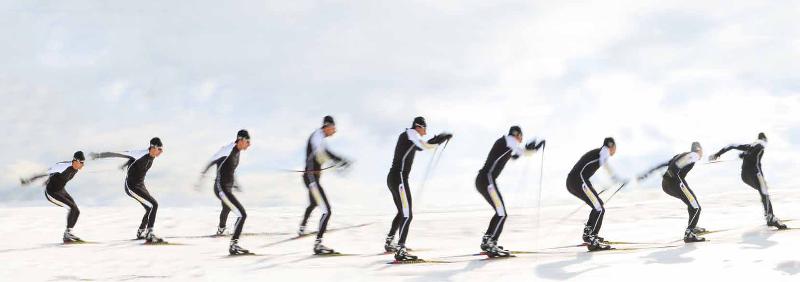
In most areas of the country we are approaching the time for the first on snow training of the year. The needs of master skiers and those who are not so lucky to ski every month during the summer are very different than high level racers who, as I write this, have just competed in the first international races of the year.
I believe it is important for all of us to have a general plan that would include how much training you want to do during this early season period, what the objectives and focus of the training should be, and what you want to accomplish through the period. In future articles we will discuss the next steps following the initial on-snow training period.
Many people get excited when they first get on snow or go to a training camp like the West Yellowstone Ski Festival and tend to over-do it on both volume and intensity. It is probable that by the time they recover/adapt from that heavy load they have lost the benefits of all that training. It is optimal for masters to have more recovery so that within 3-5 days you have reaped the benefits and are performing at a higher level (adaptation). Simply, if you are able to train a lot, perhaps more than 750 hours a year the recovery/adaptation time can be longer but with lower volumes our adaptation period has to be shorter so we don't lose fitness during recovery.
The first step in planning should be to decide how many hours of training you are prepared to handle. My recommendation would be not to increase your monthly volume more than 15-20% over the previous two to three months of training. Training more than this will probably not result in additional improvement for the time spent training.
The training effects sought for master skiers during the first snow period is different from an elite skier who has skied a lot during the summer months, who has hundreds of hours of endurance training in the bank and has important races starting during the latter half of November. Currently there is a great deal of debate on the value of so called "Base Training" and how best to accomplish it. I believe that the foundation laid in the first couple of weeks to a month or two on snow are critical for best results later in the winter. Also, 85-90% of our performance potential is derived from the correct implementation of basic endurance training. The remaining 10-15% is achieved through harder intervals, speed training and technical refinements.
My key recommendation for master or recreational skiers is to spend the first 30-50 hours of skiing primarily in a distance training mode with some occasional technique speeds. The distance training should consist of 1-2 long, 1:30-2:00 +, over-distance sessions per week done at Level 1 ~60-70% of maximum heart rate. The goal of the session is to let the duration tire you not the pace. The balance of the endurance work during the week should be 3-5 short endurance sessions done at a medium pace, Level 2 Intensity, or about 70-80% of maximum heart rate.
Many coaches and writers suggest that L2 training zone is considered "no- mans" training. However, I disagree and I believe most top endurance athletes do a large percentage of their training in this zone. We have to be careful that this training does not drift to the higher intensity levels - well controlled heart rates on the flat easier terrain in the lower reaches of this zone and on uphills does not exceed the prescribed range. These sessions should only be done when you are feeling pretty good, otherwise you should ski at a Level 1 recovery pace. From a training perspective this training should be done at a pace where good technical movements can be developed, greater muscle mass is utilized, and a higher level of endurance is developed.
The final component of endurance training I recommend is technique speeds. I encourage athletes to do 8-10-12 x 30-45 seconds within a distance session 1-2 times per week. These are not full out speeds, they are controlled accelerations focused on good technical movements and the speed only increases up to the point where good movements can be maintained or slightly faster than 5-10 Km race pace whichever comes first. Over time, these technique speeds improve nuero-muscular adaptations, speed and economy!
Of course, during this first period don't forget to maintain your regular strength training routine. Take it easy, ease into the season, and come out skiing fast!
By: Jim Galanes
Galanes Sports Lab
jimgalanes.com
|
|
Which Start Kick Wax When?
Please explain Start's kick waxes for me!
Terva-Tar: Minimizes icing in new fine grain snow. Every day wax where it snows frequently. MSRP $12.00, 6 Temps
Synthetic: Durable in old course snow. Every day wax where it snows infrequently.MSRP $12.00, 5 Temps
RF Racing Fluor: All condition high tech racing wax. MSRP $25.00, 4 Temps
Oslo Racing: Specialty wax for coarse grain, artificial & salted snow with large temp swings .MSRP $ 25.00, 3 Temps
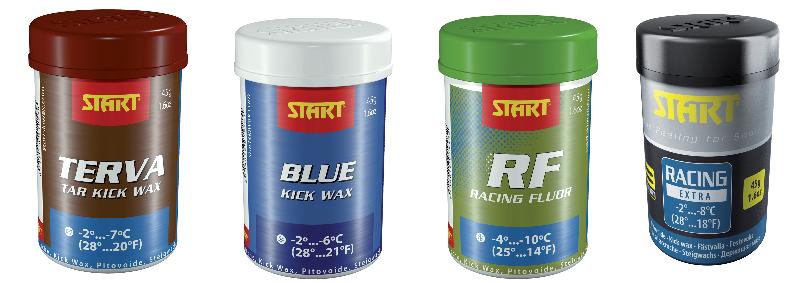
Base Wax: Keeps kicker in kick zone. MSRP $12.00: Base for normal, Extra for coarse grain snow.
MB Black Magic: Cover Wax to Reduce Dirt pickup and icing MSRP $45.00 w/Flour and $30.00 w/o
Grip Tape: Turns waxable skis into custom fit waxless skis for all conditions.Put it on once leave it on all year. MSRP $20.00
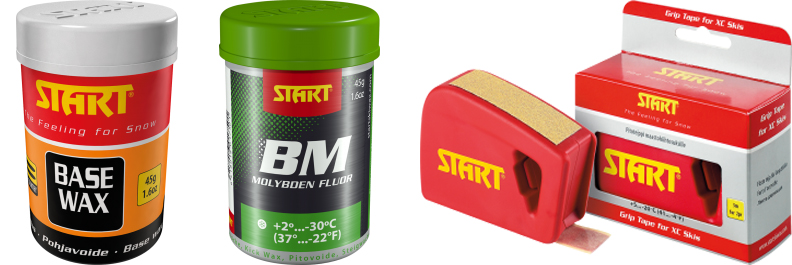
|
|
Start Green Every Day?
This is a question I got at the West Yellowstone Expo last night.
Can I just keep one pair of skis waxed for cold snow with Start Green all year?
While we encourage you to wax your skis with Start Green (SG8 ) glider for the cold days.(14F to -22F)
we encourage you to not only wax your skis with Start Green. Start Green is a very hard wax that melts at a very high temperature (140 C) and hardens very quickly. If you only apply this wax to your base the wax will never penetrate the base and just lay on top. After a few applications the base with no soft wax in it with dry out and then overheat when the hot wax droplets (or iron) touch it, causing the base to melt slightly and "seal" up. What we do recommend is that you wax with a softer wax like Start Blue SG6 (10-19F) at 130F for most of your cold days and then apply Green for your extra cold and cold race days. Start Blue is like a universal glider. Its ideal temp is 10-19F but if it colder it still runs great and if it get warmer it runs fine as well so you can use it most every day.
The key to getting a great Start Green wax job is having softer wax in your base first. If you really want to spoil your skis, start with SG4 start purple, cool scrape and brush, then apply Start Blue, cool scrape and brush, and then apply Start Green, cool scrape and brush. This layering insures your base has soft wax at its deepest layer covered by slightly harder waxes that bond together. Then finish with Start Green that bonds to the Blue and allows you to apply enough heat to get great durability and easier scraping. If you are racing for every second, go with LF08 Green on medium humidity or HF80 Green on high humidity cold conditions.
Like Start 
More info on waxing through these links.
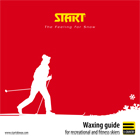 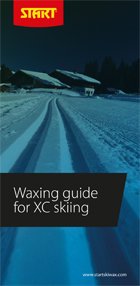 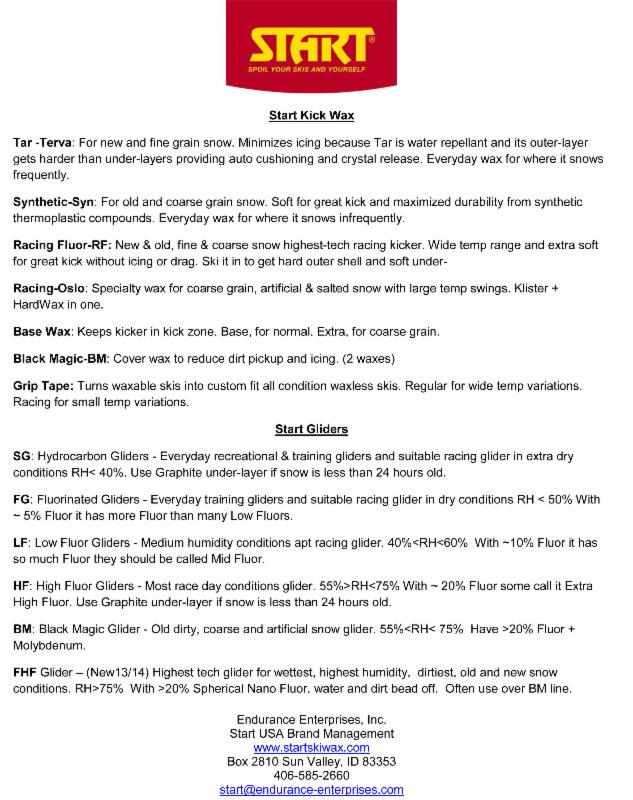
Recreational & fitness waxing guide Race Waxing Guide Start Wax Cheat sheet
|
|
2014 Equinox Ski Challenge
24 hour Equinox Ski Challenge March 22nd and 23rd at the Rendezvous Ski Trails in West Yellowstone, MT! Check out the website at www.equinoxsnowchallenge.com for full details
|
|
Lone Mountain Ranch
Big Sky, MT
Winter Trails Day- Saturday, January 11, 2014 10am-3pm
Winter Trails Day offers children and adults new to snow sports the chance to try snowshoeing and cross country skiing for free, and to discover the great fitness and social benefits with these easy-to-learn winter sports.Cost: Free ski pass, $5/ rentals, $5/ lessons, $10/ lunch. Contact: 406.995.4644 for more information.
|
|
Steamboat Nordic Camp - Registration Open
|
|
Women's Ski Weekend
Women's Ski Weekend
December 7 & 8, 2013 (Saturday & Sunday) or January 11 & 12 2014 (Saturday & Sunday)
2 skate ski lessons; 1 guided night classical ski tour; 2 yoga sessions; 1-30 minute massage; 1 night stay at the Izaak Walton Inn in Montana
New This Season *Women's Classic Getaway*
February 7 & 8, 2014 (Friday & Saturday)
2 classical ski lessons; 1 guided night classical ski tour; 2 yoga sessions; 1-30 minute massage; 1 night stay at the Izaak Walton Inn
All the information, including a flyer, instructor bios and detailed itinerary can be found at
http://brendawinkler.com
|
About SkiPost
Cross-Country skiing's community lodge. Where knowledge and stories are shared. The goal of SkiPost is to make the sport of Cross-Country skiing easier and more enjoyable for all who choose to participate. If you have questions on Cross-Country Skiing email us weanswer@SkiPost.com and visit SkiPost.com
Enjoy Winter,
Andrew Gerlach
Director/Editor- SkiPost
|
|